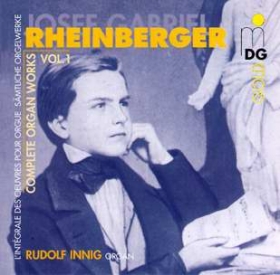
MDG 317 0891-2
Rudolf Innig, Orgel
Walcker Orgel in St. Maria, Schramberg
Josef Rheinberger (1839-1901)
Complete Organ Works Vol. 1
Three Fughettas (1851)
Three Preludes and Fugues (1854)
Five Pieces out of WoO 25 Great Fugue JWV 3 (1853)
F minor / fa mineur / f-Moll Four Versets JWV 151 (1858)
Fuge WoO 10 (1867)
F minor / fa mineur / f-Moll Five Pieces for Organ
Sonata No. 1 op. 27 (1869)
C minor / do mineur / c-Moll
Excerpts from the booklet
Rheinberger’s early compositions for organ show that he was a gifted contrapuntist who was gradually able to find his own musical language amid the remarkable intricate texture of the various voices (c. the two f – Minor Fugues). Almost every tone in his fugues seems to have its thematic foundation, which means that the refrains from the effect of presenting the subject once again in its melodic form after free episodes. Instead, for him contrapuntal thinking stamps the whole compositional design. In his free preludes (Präludien and Vorspiele) some of which have a purely functional character and were intended for organists with a limited command of playing technique, however, there are clear traces of his talent on the field of the character piece, even if his great model Mendelssohn in occasionally too much in evidence. The pieces on the compact disc document Rheinberger’s development as an organ composer from the age of twelve to the age of twenty – nine and hos way from a very able counterpoint student to the beginning of the second flourishing of the organ sonata after Mendelssohn. (Dr. Irmlind Capelle)
Excerpts from the reviews
„So ist der Plan von MDG, die Reihe ihrer Komponisteneditionen nun mit Josef Gabriel Rheinberger fortzusetzen, nur zu begrüßen, vor allem, wenn der Interpret ein so ausgewiesener Kenner ist wie Rudolf Innig an der restaurierten Kegelladen Orgel in St. Maria Schramberg (1844). Hervorragend!“ (FonoForum, 1999)
„Rudolf Innig spielt im besten Sinne virtuos, in den Ecksätzen der Sonaten brillant, aber nicht reißerisch, in den langsamen Sätzen mit Emphase. Besonders spannend gelingen ihm die Finalfugen mit kraftvollen Crescendi und schlüssigen Stringendi. In den ruhigeren Passagen verzaubern Instrument und Interpret mit samtigen Registerfarben und absolut stimmiger romantischer Ästhetik.“(Idea Spektrum , 1999)
„Ein ganz vorzüglicher Auftakt für etliche Rheinberger – Monate!“ (Klassik heute, 2000)
„Innig’s performances are consistently intelligent and committed; he brings dignity and grandeur to the louder passages, and grace and charm to the slower, softer movements. The Walcker organ dates from around the same time as the music, and is thus ideally suited to this repertoire. The recorded sound is excellent, and the CD is accompanied by a comprehensive and informative booklet. A very worthwhile release.” (Gramophone, 1999)
“Rudolf Innig’s playing is convincing both musically and technically.” (Cathedral Music, 2000)
Très beau disque pour spécialistes de l’orgue romantiques allemande.” (Répertoire, 1999)

